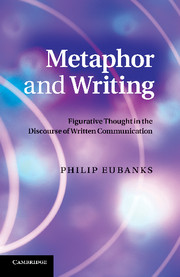Book contents
- Frontmatter
- Contents
- List of figures
- List of tables
- Acknowledgements
- Introduction
- 1 In search of the figurative rhetoric of writing
- 2 The double bind of writer and to write: Graded categories
- 3 Bind upon bind: The general-ability and the specific-expertise views of writing
- 4 Three licensing stories: The literate inscriber, the good writer, and the author writer
- 5 Writing as transcription, talk, and voice: A complex metonymy
- 6 The writing self: Conceptual blends, multiple selves
- 7 Writing to “get ideas across”: The role of the Conduit Metaphor
- 8 Codes and conversations: The other Conduit Metaphor
- 9 Metaphor and choice
- References
- Index
7 - Writing to “get ideas across”: The role of the Conduit Metaphor
Published online by Cambridge University Press: 06 December 2010
- Frontmatter
- Contents
- List of figures
- List of tables
- Acknowledgements
- Introduction
- 1 In search of the figurative rhetoric of writing
- 2 The double bind of writer and to write: Graded categories
- 3 Bind upon bind: The general-ability and the specific-expertise views of writing
- 4 Three licensing stories: The literate inscriber, the good writer, and the author writer
- 5 Writing as transcription, talk, and voice: A complex metonymy
- 6 The writing self: Conceptual blends, multiple selves
- 7 Writing to “get ideas across”: The role of the Conduit Metaphor
- 8 Codes and conversations: The other Conduit Metaphor
- 9 Metaphor and choice
- References
- Index
Summary
What we've got here is a failure to communicate.
Captain, Cool Hand LukeI believe I can say, without overstating the case, that no element of our figurative rhetoric of writing is more important than the Conduit Metaphor. It is known by various names such as “the container metaphor,” “the transmission model,” “the code model,” and in Carolyn Miller's well-known formulation the “windowpane theory of communication.” According to the Conduit Metaphor, language contains meaning; speakers and writers use linguistic containers to send meaning to audiences; and, at the end of the line, audiences remove the unaltered meaning from its container. Many language scholars, including writing specialists, have raised objections to the Conduit Metaphor, objections that vary in motivation and rationale. What is most striking to me, however, is not the variety of analysis applied to the Conduit Metaphor but the nearly unanimous condemnation the metaphor elicits.
Almost universally, current language scholars object that language is fundamentally indirect, imprecise, contingent, and unstable; thus we never transmit a perfect representation of the “external” world through a secure pipeline leading from giver to receiver (e.g., Miller 1979; Bizzell 1982; Slack, Miller, and Doak 1993; Axley 1996; Weiss 1997; Prior 1998; Bowden 1999; Longo 2000; Evans 2003; Cowley and Love 2006; Krzeszowski 2006). In short, most of us have said that the Conduit Metaphor is wrong because language does not work the way the metaphor assumes.
- Type
- Chapter
- Information
- Metaphor and WritingFigurative Thought in the Discourse of Written Communication, pp. 142 - 169Publisher: Cambridge University PressPrint publication year: 2010



